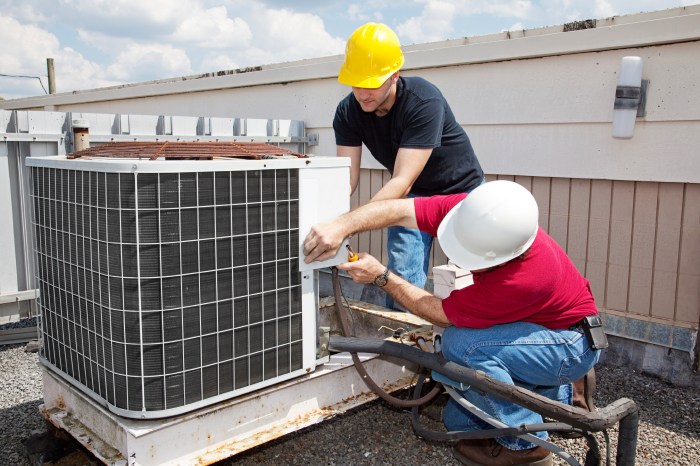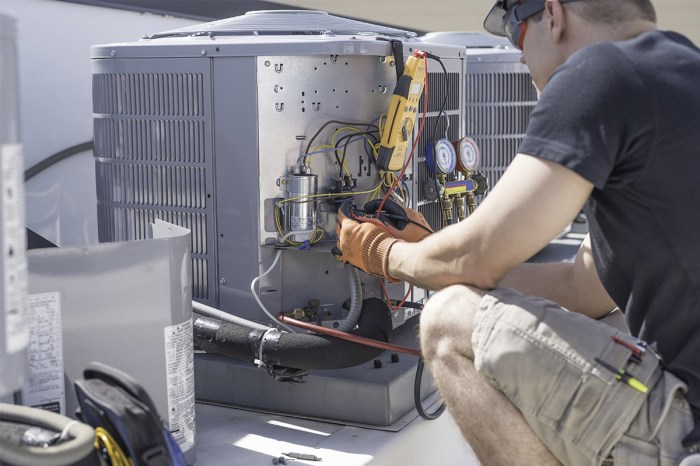Exploring the realm of central AC repair, this guide delves into the nuances of maintenance, common issues, repair processes, and cost considerations. Whether you're a seasoned DIY enthusiast or prefer professional help, this resource offers valuable insights to keep your central AC system running smoothly.
From understanding the importance of regular maintenance to weighing the pros and cons of DIY versus professional repairs, this guide covers it all in a detailed and informative manner.
Introduction to Central AC Repair
Regular maintenance of central AC systems is crucial to ensure optimal performance and longevity. Neglecting maintenance can lead to inefficiencies, breakdowns, and costly repairs.
Common issues that may require repair in central AC units include refrigerant leaks, compressor failure, electrical problems, and sensor issues. These issues can impact the cooling capacity and efficiency of the system.
Benefits of Professional Repair Services
- Expertise: Professional technicians have the knowledge and experience to diagnose and repair complex issues accurately.
- Quality Workmanship: Professional repairs are done using high-quality parts and tools, ensuring long-lasting solutions.
- Time and Cost Savings: Professional repairs can save time and money in the long run by preventing further damage and the need for frequent repairs.
- Safety: Professionals follow safety protocols to prevent accidents and ensure the proper functioning of the AC system.
Signs of Central AC Problems

Central air conditioning systems can develop issues over time, affecting their performance and efficiency. Recognizing the signs of potential problems early on can help prevent costly repairs and ensure your AC unit functions optimally.
Unusual Sounds
If you start hearing strange noises coming from your central AC unit, such as grinding, banging, or squealing, it could indicate a problem. These noises may be due to a malfunctioning motor, loose parts, or a damaged fan. Ignoring these sounds can lead to further damage to the system and potentially result in a complete breakdown.
Unpleasant Odors
Foul odors emanating from your vents when the AC is running can be a sign of mold or mildew growth within the system. This can not only affect the air quality in your home but also indicate a problem with the unit's drainage system.
Neglecting this issue could lead to respiratory problems for occupants and reduce the overall efficiency of the AC.
Inconsistent Cooling or Cycling
If you notice that certain areas of your home are not getting adequately cooled or that the AC unit is constantly turning on and off, there may be an underlying issue with the system. This could be caused by a refrigerant leak, clogged filters, or a failing thermostat.
Overlooking these problems can result in higher energy bills and a decreased lifespan of the central AC unit.
Increased Energy Bills
One of the most common signs of central AC problems is a sudden spike in energy bills without any significant changes in usage habits. This could indicate that the unit is working harder than usual to cool your home, likely due to issues like dirty coils, low refrigerant levels, or a malfunctioning compressor.
Addressing these problems promptly can help you save on energy costs and prevent major breakdowns.
Conclusion
Being proactive in identifying and addressing these signs of central AC problems can help you avoid costly repairs and ensure the longevity of your cooling system. Regular maintenance and timely repairs can improve the overall performance and efficiency of your central air conditioning unit.
Central AC Repair Process
When it comes to repairing a central AC unit, there are several typical steps involved in the process. It is important to follow these steps carefully to ensure the repair is done correctly and safely.
Steps Involved in Repairing a Central AC Unit
- 1. Diagnosing the Problem:The first step in repairing a central AC unit is to diagnose the issue. This may involve checking for leaks, testing the electrical connections, or inspecting the compressor.
- 2. Gathering the Necessary Tools and Equipment:Common tools needed for central AC repair include a multimeter, refrigerant gauges, a vacuum pump, and various wrenches and screwdrivers.
- 3. Turning Off the Power:Before beginning any repair work, it is important to turn off the power to the AC unit to prevent any electrical accidents.
- 4. Repairing or Replacing Faulty Components:Once the problem has been identified, the next step is to repair or replace any faulty components. This could include replacing a capacitor, fixing a refrigerant leak, or cleaning the condenser coils.
- 5. Testing the System:After completing the repair, it is essential to test the system to ensure that the issue has been resolved and that the AC unit is functioning properly.
- 6. Performing Regular Maintenance:To prevent future issues, it is important to perform regular maintenance on the central AC unit, such as cleaning or replacing air filters, checking refrigerant levels, and inspecting the ductwork.
Safety Precautions during the Repair Process
- 1. Wear Protective Gear:When working on a central AC unit, always wear protective gear such as gloves, safety glasses, and closed-toe shoes to prevent injuries.
- 2. Use Caution with Electrical Components:Be sure to turn off the power before working on the AC unit and handle electrical components with care to avoid electric shocks.
- 3. Properly Ventilate the Area:When working with refrigerants or other chemicals, make sure the area is well-ventilated to prevent exposure to harmful fumes.
- 4. Follow Manufacturer Instructions:Always follow the manufacturer's instructions and guidelines when repairing a central AC unit to ensure the repair is done correctly and safely.
DIY vs. Professional Repair
When it comes to central AC repair, homeowners often face the decision of whether to attempt a do-it-yourself (DIY) fix or seek professional help. Each option has its advantages and disadvantages, so it's important to weigh them carefully before deciding on the best course of action.
Advantages and Disadvantages of DIY Central AC Repairs
DIY central AC repairs can be cost-effective and convenient for minor issues such as changing air filters or cleaning coils. However, they may lack the expertise and tools needed for more complex problems, leading to incomplete repairs or even causing further damage.
Determining When to DIY and When to Seek Professional Help
As a rule of thumb, simple maintenance tasks like cleaning and changing filters can be done DIY. However, if you're dealing with refrigerant leaks, electrical issues, or compressor problems, it's best to leave it to the professionals to avoid safety hazards and costly mistakes.
Risks of Attempting Complex Repairs Without Proper Knowledge
Attempting complex central AC repairs without the necessary knowledge and experience can lead to serious consequences. Inaccurate repairs can worsen the problem, compromise system efficiency, or even pose safety risks. It's crucial to know your limits and seek professional help when in doubt.
Cost of Central AC Repair
Repairing a central AC unit can be a significant expense, and the cost can vary depending on several factors. Understanding what influences the cost of central AC repair can help you budget and plan for unexpected expenses.
Factors Influencing Repair Costs
- The extent of the damage or issue: The severity of the problem with your central AC unit will greatly impact the cost of repairs. Minor issues may only require simple fixes, while major problems could involve more complex and costly solutions.
- The age of the unit: Older central AC units may require more frequent repairs and replacement parts, which can add to the overall cost.
- The brand and model of the unit: Some brands and models of central AC units may have more expensive parts or may be more difficult to repair, affecting the cost of the repair service.
- Location and accessibility: The location of your central AC unit and how easily accessible it is can also influence repair costs. Units in hard-to-reach areas may require more labor and time, increasing the overall cost.
Estimates for Common Repair Services and Replacement Parts
- Refrigerant recharge: $150 - $500
- Compressor replacement: $1,500 - $2,500
- Thermostat replacement: $200 - $500
- Evaporator coil replacement: $650 - $1,200
- Condenser coil replacement: $900 - $2,500
Budgeting and Planning for Repair Expenses
- Regular maintenance: Investing in regular maintenance for your central AC unit can help prevent costly repairs in the future.
- Setting aside a repair fund: Consider setting aside a portion of your budget specifically for unexpected repair expenses related to your central AC unit.
- Getting multiple quotes: When facing a repair, it's a good idea to get quotes from multiple HVAC professionals to ensure you're getting a fair price for the services needed.
Closure

In conclusion, central AC repair is a crucial aspect of maintaining a comfortable indoor environment. By staying informed about common issues, repair processes, and cost factors, you can make informed decisions to ensure your central AC unit performs optimally. Whether you choose the DIY route or opt for professional assistance, regular maintenance and timely repairs are key to extending the lifespan of your central AC system.
Common Queries
What are the benefits of professional repair services over DIY repairs?
Professional repair services offer expertise, specialized tools, and warranties that guarantee quality workmanship, whereas DIY repairs may lack the same level of precision and could void warranties.
How can neglecting minor issues impact the overall performance of a central AC system?
Neglecting minor issues can lead to more significant problems over time, such as reduced efficiency, higher energy bills, and potential system breakdowns that require costly repairs.
What factors influence the cost of repairing a central AC unit?
The cost of central AC repair can vary based on the extent of damage, the need for replacement parts, labor costs, and the complexity of the repair tasks involved.
When should you opt for DIY repairs versus professional help for central AC issues?
Simple tasks like changing filters or cleaning coils can often be done DIY, but complex issues like refrigerant leaks or electrical problems are best left to professionals to avoid safety risks and further damage.
